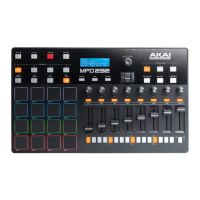14
Sequencer
MPD232 has a powerful step sequencer, letting you create, edit, and play sequences quickly
and easily. A sequence is, essentially, a pattern that you can use as part of a song. Some
songs may use only one sequence while others may use several sequences in a complex song
structure. MPD232’s sequences may be up to 32 steps long. Each step is a “note event” (a
MIDI Note On message).
Before creating a sequence, you may want to determine two important aspects of how it will
sound: its length (see Steps below) and its timing settings (see Timing below).
The most intuitive way to create a sequence is to record it in real time with MPD232’s pads
(see Recording), but you may also want to work more precisely and fine-tune it using the step
buttons and Sequence Edit Mode (see Editing).
Steps
The subdivisions of a sequence are represented by 32 “steps” by the step buttons, 16 at a
time. The step buttons show the steps for one pad at a time, indicated in the display. You can
press the step buttons to quickly add or remove note events to or from a sequence.
To set the number of steps in a sequence:
1. Press Edit to enter Edit Mode.
2. Press the Step Bank button. Sequence Edit will appear at the top of the display.
3. Use the Up/Down Cursors to select Steps.
4. Turn the Data Dial to change the number of steps. The available range is 01–32.
In this window, you can also set what commands the sequencer uses to start or stop
playback as well as how the step buttons show the sequence during playback. See
Edit Mode > Sequence Edit (Step Bank) to learn more.
Timing
MPD232’s sequencer uses four timing settings: tempo, time division, swing, and gate. These
settings are saved in the Program. They affect the Note Repeat feature as well as the sequencer.
Important: This setting is for MPD232’s internal sequencer, which can be used to send MIDI
Clock to external MIDI devices and/or some DAWs that support it. Similarly, if you want
MPD232 to follow your DAW’s tempo, set your DAW to use its own MIDI Clock (if applicable)
and set MPD232 to receive it. See Global Mode > Clock to learn how to do this.
To set the timing settings:
1. Press Edit to enter Edit Mode.
2. Press Tap Tempo. Tempo will appear at the top of the display.
3. Use the Up/Down Cursors to select any of the four fields, and turn the Data Dial to adjust
the value or setting:
• BPM: The tempo as indicated in beats per minute. The available range is 30–300 BPM.
• Time Division: The speed of the Note Repeat repetition as a division of the master
tempo or external clock. The available options are 1/4, 1/4T, 1/8, 1/8T, 1/16, 1/16T,
1/32, and 1/32T. (T denotes a triplet-based time division.)
Important: The time division affects how swing is applied. The time division does not
affect the number of steps.

